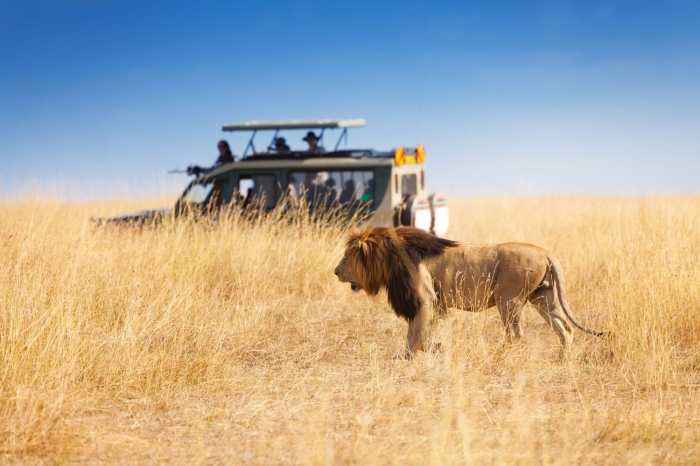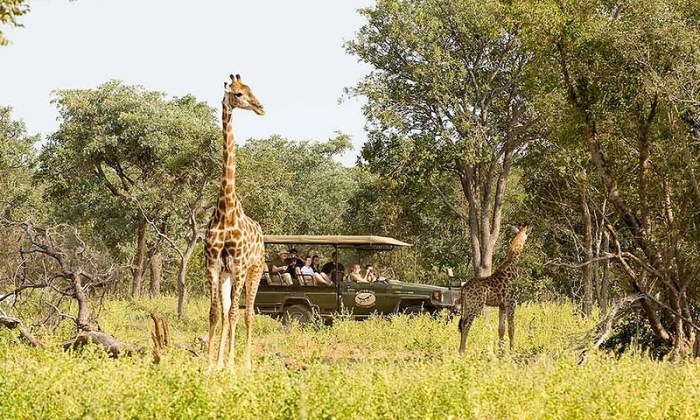
Embark on a journey to the future of safari adventures with a focus on the best destinations anticipated for 2025. Discover the allure of these upcoming hotspots and how they cater to evolving traveler preferences and sustainability concerns.
Delve into the realm of luxury lodges, captivating wildlife encounters, thrilling safari activities, and innovative trends shaping the safari landscape for 2025.
Safari Destinations in 2025
In the coming years, several emerging safari destinations are poised to capture the attention of adventurous travelers seeking unique wildlife experiences. These destinations are gaining popularity due to their pristine landscapes, diverse flora and fauna, and commitment to sustainable tourism practices.
Emerging Safari Destinations
- Madagascar: Known for its endemic wildlife, including lemurs and chameleons, Madagascar is becoming a top choice for nature enthusiasts looking to explore biodiverse ecosystems.
- Namibia: With its vast deserts, rugged mountains, and abundant wildlife, Namibia offers a truly off-the-beaten-path safari experience for those seeking adventure.
- Rwanda: Famous for its mountain gorilla trekking experiences, Rwanda’s lush rainforests and conservation efforts are attracting eco-conscious travelers interested in sustainable tourism.
Factors Influencing Appeal
- Biodiversity: The rich biodiversity of these emerging destinations, with unique species and ecosystems, appeals to safari enthusiasts looking for a one-of-a-kind wildlife experience.
- Sustainability: Increasingly, travelers are prioritizing destinations that focus on conservation and sustainable practices, making these emerging safari spots attractive for eco-conscious visitors.
- Cultural Experiences: In addition to wildlife encounters, these destinations offer cultural immersion opportunities, allowing travelers to engage with local communities and traditions.
Adapting to Changing Preferences
- Community Involvement: Many of these destinations are involving local communities in tourism initiatives, creating economic opportunities and fostering a sense of ownership over conservation efforts.
- Eco-Friendly Practices: From eco-lodges to wildlife conservation projects, these destinations are implementing sustainable practices to minimize their environmental impact and preserve natural habitats.
- Technology Integration: To enhance visitor experiences and streamline operations, emerging safari destinations are leveraging technology, such as mobile apps for guided tours and wildlife tracking.
Best Safari Lodges and Camps
In 2025, the top luxury safari lodges and camps are expected to offer unparalleled experiences in some of the most breathtaking natural settings. These accommodations not only provide comfort and luxury but also prioritize sustainability and environmental conservation.
Luxury Safari Lodges and Camps
- 1. Singita Lebombo Lodge – Located in South Africa’s Kruger National Park, this lodge offers stunning views of the bushveld and the N’wanetsi River. It features contemporary design, gourmet dining, and exclusive access to wildlife-rich areas.
- 2. &Beyond Ngorongoro Crater Lodge – Situated on the edge of the Ngorongoro Crater in Tanzania, this lodge offers opulent suites with breathtaking views of the crater. Guests can enjoy guided safaris, cultural experiences, and fine dining.
- 3. Mombo Camp – Found in Botswana’s Okavango Delta, this camp provides luxurious tented accommodation amidst abundant wildlife. Guests can partake in game drives, walking safaris, and stargazing experiences.
Sustainability Practices
- Many top safari lodges and camps in 2025 are committed to sustainable practices to preserve the natural environment. This includes initiatives such as waste reduction, water conservation, renewable energy use, and community engagement.
- Some lodges participate in conservation projects, wildlife rehabilitation, and anti-poaching efforts to protect endangered species and ecosystems.
- Guests can also contribute to conservation efforts through eco-friendly activities, such as tree planting, wildlife monitoring, and educational programs on environmental stewardship.
Wildlife Encounters
When it comes to wildlife encounters in the best safari destinations for 2025, visitors can expect to witness a diverse array of animals in their natural habitats. From majestic lions roaming the savannah to graceful giraffes browsing on acacia trees, the opportunities for up-close wildlife viewing are unparalleled.
Conservation Efforts and Initiatives
Many of these top safari destinations are actively involved in conservation efforts to protect and preserve the wildlife that calls these areas home. Conservation initiatives include anti-poaching patrols, habitat restoration projects, and community-based conservation programs that aim to ensure the long-term sustainability of the local ecosystems.
Role of Technology in Wildlife Viewing
Technology plays a significant role in enhancing wildlife viewing experiences for tourists in 2025. From GPS tracking devices that allow visitors to locate animals more easily to remote live-streaming cameras that provide real-time footage of wildlife activities, advancements in technology have made it possible for tourists to have a more immersive and informative safari experience.
Safari Activities and Experiences
In 2025, travelers can expect a wide range of exciting safari activities and experiences that will immerse them in the beauty of the natural world and wildlife.Exploring the cultural aspects of a destination and engaging with local communities have become integral parts of safari itineraries. Travelers can participate in cultural exchanges, visit local markets, interact with indigenous tribes, and even take part in community development projects.
This not only enriches the safari experience but also promotes sustainable tourism and supports local livelihoods.
Exciting Safari Activities
- Game drives through national parks and reserves
- Balloon safaris offering a bird’s eye view of the landscape
- Bush walks with experienced guides for a closer encounter with nature
- Photographic safaris to capture stunning wildlife moments
- Canoe safaris along rivers to spot aquatic wildlife
Cultural Interactions and Community Engagement
- Visiting local villages and experiencing traditional ceremonies
- Learning about indigenous cultures and customs from local guides
- Participating in community-based tourism initiatives
- Supporting local artisans by purchasing handmade crafts
Adventure Options in Different Safari Destinations
- Kenya: Offers a mix of wildlife safaris, cultural experiences, and beach holidays
- Botswana: Known for its exclusive luxury camps and diverse wildlife viewing opportunities
- South Africa: Provides a combination of Big Five safaris, wine tasting, and scenic drives along the Garden Route
- Tanzania: Home to the iconic Serengeti National Park and the breathtaking Ngorongoro Crater
Safari Trends and Innovations

As safari tourism continues to evolve, several trends and innovations are shaping the future of this unique travel experience. From eco-friendly practices to personalized adventures, the safari industry is embracing change to meet the demands of modern travelers.
Eco-friendly Safaris
One of the most prominent trends in safari tourism is the shift towards eco-friendly practices. Many safari operators are now focusing on sustainable tourism initiatives, such as reducing carbon footprints, supporting local conservation efforts, and promoting wildlife protection. By choosing eco-friendly safaris, travelers can minimize their impact on the environment and contribute to the preservation of natural habitats.
Technological Innovations
Advancements in technology are also enhancing the safari experience for travelers. From virtual reality safaris to drone photography, innovative technologies are allowing visitors to engage with wildlife in new and exciting ways. GPS tracking devices are being used to monitor animal movements, while mobile apps provide real-time updates on safari sightings. These technological innovations are revolutionizing the traditional safari experience and creating opportunities for more immersive and interactive adventures.
Climate Change and Conservation Efforts
Climate change and conservation efforts are playing a significant role in shaping the future of safaris. As global temperatures rise and natural habitats come under threat, the need for sustainable conservation practices has never been more critical. Many safari lodges and camps are implementing eco-friendly initiatives to reduce their environmental impact and protect endangered species. Conservation efforts are not only essential for preserving biodiversity but also for ensuring the long-term viability of safari tourism.
Sustainable Tourism Practices
In recent years, the focus on sustainable tourism practices in the safari industry has been increasing. Safari operators and destinations are implementing various initiatives to minimize their environmental impact, preserve wildlife habitats, and support local communities.
Examples of Successful Eco-Friendly Practices
- Use of renewable energy sources such as solar panels to power lodges and camps.
- Implementation of waste management systems to reduce plastic and other waste in protected areas.
- Supporting local conservation projects and community initiatives through tourism revenue.
- Promoting responsible wildlife viewing guidelines to minimize disturbance to animals.
Importance of Responsible Tourism
Responsible tourism plays a crucial role in preserving the delicate balance of wildlife ecosystems and habitats. By adopting sustainable practices, safari operators not only protect the environment but also contribute to the well-being of local communities who depend on wildlife for their livelihoods. It is essential to prioritize responsible tourism to ensure the long-term viability of safari destinations and the conservation of wildlife for future generations.
Safari Packing Tips and Essentials
When preparing for a safari adventure in 2025, it is crucial to pack wisely to ensure a comfortable and enjoyable experience. Here are essential items travelers should consider bringing along:
Clothing
- Lightweight, breathable clothing in neutral colors for blending in with the surroundings.
- Long-sleeved shirts and pants to protect against the sun, insects, and thorny bushes.
- A wide-brimmed hat and sunglasses for sun protection.
- Sturdy, comfortable walking shoes or boots for exploring the terrain.
Gear and Accessories
- A high-quality camera with extra batteries and memory cards to capture wildlife moments.
- Binoculars for better wildlife viewing from a distance.
- A lightweight backpack for carrying essentials during game drives and walks.
- A reusable water bottle to stay hydrated and reduce plastic waste.
Sustainable and Eco-Friendly Products
When selecting items for your safari packing list, opt for eco-friendly and sustainable products to minimize your impact on the environment. Consider the following:
- Biodegradable toiletries to avoid harmful chemicals in the wilderness.
- Solar-powered chargers for electronic devices to reduce reliance on disposable batteries.
- Reusable and recyclable items such as bags, utensils, and containers to minimize waste generation.
- Clothing made from sustainable materials like organic cotton or recycled fabrics to support ethical fashion practices.
Safari Photography Tips

Capturing stunning wildlife and landscape photos during a safari requires skill and the right equipment. Here are some expert tips to help you take amazing shots while respecting the animals and their environment.
Best Camera Equipment and Settings
When photographing wildlife in action, it’s essential to have a camera with a fast shutter speed to freeze the movement. A telephoto lens will also allow you to capture animals from a safe distance without disturbing them. Set your camera to a high ISO to compensate for low light conditions, and use a wide aperture to create a blurry background that makes the subject stand out.
Ethical Wildlife Photography Practices
Respect the animals by keeping a safe distance and avoiding any behavior that could stress or harm them. Always follow the guidelines provided by your guide or the park authorities. Remember that the welfare of the animals should come before getting the perfect shot. Use natural light whenever possible and avoid using flash, especially at night or with nocturnal animals.
End of Discussion
As we conclude our exploration of the best safari destinations for 2025, it’s evident that the future holds exciting prospects for wildlife enthusiasts and eco-conscious travelers alike. From sustainable practices to immersive experiences, the safari industry is poised for a remarkable evolution in the years to come.
Commonly Asked Questions
What are some emerging safari destinations for 2025?
Emerging safari destinations for 2025 include destinations like X and Y, which are expected to gain popularity due to Z factors.
What unique features can be found in the top luxury safari lodges and camps for 2025?
The top luxury safari lodges and camps for 2025 boast unique features such as A, B, and C, setting them apart as premier accommodations.
How is technology enhancing wildlife viewing experiences for tourists in the best safari destinations for 2025?
Technology is revolutionizing wildlife viewing experiences by enabling D, E, and F in the best safari destinations for 2025, providing unparalleled encounters with nature.
What sustainable tourism practices are safari operators adopting for 2025?
Safari operators are embracing sustainable practices like G, H, and I to reduce environmental impact and support conservation efforts in the safari industry for 2025.
Why are sustainable and eco-friendly products important for safari travel in 2025?
Sustainable and eco-friendly products play a crucial role in minimizing ecological footprint and preserving the natural beauty of safari destinations for future generations.





